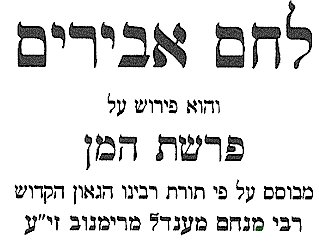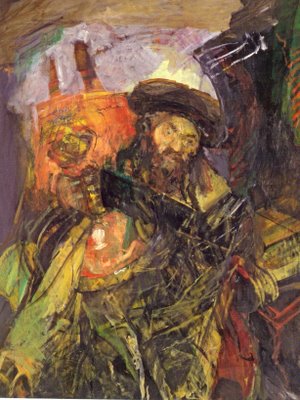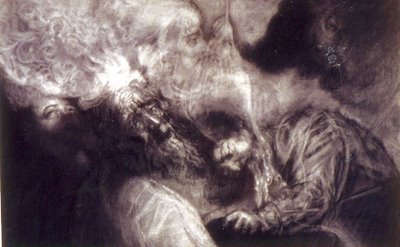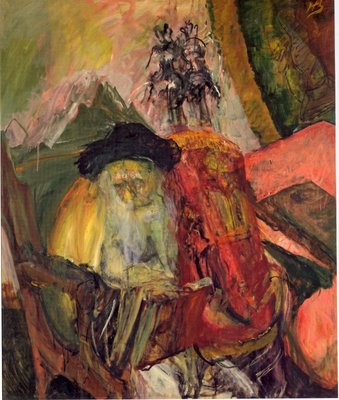Free MP3 Chassidus Shiurim - Download Links
אַשְׂכִּילָה בְּדֶרֶךְ תָּמִים
Said the Sassover Rebbe: "Whoever does not have one hour a day for himself is not a human being!"



We should learn to be careful of every move we make in life, just as a chess player takes great precaution before he makes a move. Before making a decision, we should think in advance whether we will have cause to regret it.
By fulfilling a mitzvah you impart life to the limb or organ with which you do the mitzvah. If you fail to do a mitzvah, the limb that is associated with this mitzvah will be deprived of its life-force and will become deceased.
Dixie Yid: The Story Behind the Story, Part 2
Shoshana (Bershad) commenting on A Footnote About His Life:
I’ve been trying to find some more information about the name of the Degel’s wife but have been unable to find anything further in online sources. I did, however, come up with a loose timeline and some background. According to some sources, Israel ben Eliezer, the Ba’al Shem Tov (1698-1760), first married at about age 18; his wife died soon thereafter. Around 1720, he married Leah Rachel (or Chanah), the daughter of Rabbi Ephraim of Brody. His wife’s brother was Rabbi Abraham Gershon Ashkenazi of Kuty (also known as Gershon Kittower or Kitover). He was the rabbi of Brody and a well-known Talmudic scholar and Cabalist. Since the Ba’al Shem Tov presented himself as an ignorant peasant, R’ Gershon at first disapproved of the match. In later years, however, he became one of the Ba’al Shem Tov’s most ardent followers. R’ Gershon traveled to Palestine in ~1742 and started the first Chassidic community there. Although many sources state that he arrived in Hebron in 1746 or 1747, there is a tradition that he studied Cabala in Jerusalem before 1743. According to a letter he wrote in 1757, he had lived in Hebron for 6 years [1743?-1749?] without his family (“Gershon relates that in the single Jewish courtyard there was so little room that they could not even let him bring his family”). He then went to the Beit El Synagogue (Yeshivat haMekubalim) in Jerusalem, where he lived for 4 years [1749?-1753?] with his wife and family. The famous letter from the Ba’al Shem Tov to R’ Gershon was written in 1752; in it, he refers to R’ Gershon’s wife, Bluma, and children. Apparently, R’ Gershon returned to Brody [~1753?] to arrange marriages for his sons and then returned to Jerusalem, where he died around 1760 (or 1765). The grandson of the Ba’al Shem Tov, the Degel (Moshe Chaim Ephraim of Sudilkov), was the son of the Ba’al Shem Tov’s daughter, Udel (Adel), and R’ Yechiel Ashkenazi. He is believed to have married a daughter of R’ Gershon. The Degel was born in 1748, around the time that R’ Gershon’s family moved to Jerusalem. If his future wife was born ~1750 in Palestine (when R’ Gershon was perhaps in his late 50s or early 60s and his wife, Bluma, was, presumably, much younger) and she returned to the Ukraine ~1753, she might have married the Degel in 1764 (the year they are listed together in the census). R’ Gershon would thus be BOTH the father-in-law of the Degel and his great-uncle! By the way, it occurs to me that the Degel’s wife might actually be a granddaughter of R’ Gershon; however, I could find no support for this hypothesis. (Some of the sources for this information are the Jewish Encyclopedia, BibleWiki, the Kuty Memorial Book, the RavSIG on JewishGen, the Jewish Agency for Israel web site, the Tluste/Tovste web site, the Baal Shem Tov Foundation web site, the McGrew.net web site, the Nehora web site, and the Grossman Project web site. Links available.)
A Simple Jew's comment:
There is some support to your hypothesis. On page 62 of the book "The Circle of the Baal Shem Tov", Abraham J. Heschel wrote: "Before leaving, R. Gershon secured the future marriage of his youngest daughter to R. Ephraim, the Besht's grandson, the future author of Degel Mahaney 'Efrayim. He seems to have promised to return to the Diaspora to give her in marriage."
On an interesting side note, "The Encyclopedia of Hasidism" by Tzvi M. Rabinowicz relates, "He [Rabbi Gershon of Kitov] was buried on the Mount of Olives. For more than two hundred years, his grave could not be found. Only after the Six-Day War (1967) were his grave and that of his wife (d. 1757) discovered."
When a person repeats a lie twice, it becomes the truth for him. Having repeated it twice, he believes it is the truth. Not only does he deceive himself; he even has the power to deceive others and to cause such intense concealment that it seems as if even God agrees with him.
 Dixie Yid: The Story Behind the Story, Part 1
Dixie Yid: The Story Behind the Story, Part 1 
All worry is forbidden – except the worry about being worried.
In a past conversation on this posting, the Sudilkover Rebbe told me about an article he wrote on this subject and suggested that I post an English translation on my blog. Unfortunately my Hebrew is not good enough to do the translation so I was wondering if anyone out there would be willing to translate it for a posting.
One may not be worthy of having his prayers answered, but for the sincerity of his entreaties and the tears in his eyes.

It's not hard to push a person away. The real work is to draw him close and uplift him.
If you see that someone sometimes serves Hashem and sometimes does not, you can be sure that he has never really served Hashem as he should. For if he had served Hashem even once as he should, then he would serve Him continuously.
Moshe spoke in a kindly manner to Pharaoh even while delivering a warning of a devastating plaque. G-d warned him to do so as otherwise he might have lived up to the description in Tehillim of the tzaddik who rejoices when he observes G-d taking revenge. Moshe is reminded that what truly makes tzaddikim happy is seeing G-d's attribute of mercy in action.
Received today via e-mail from the Chofetz Chaim Heritage Foundation:
 (Picture courtesy of Greenfeldjudaica.com)
(Picture courtesy of Greenfeldjudaica.com)
When you believe that everything is from Him, blessed be He, then there is no evil or bad at all - there is just all good.
I received a tradition that any Jew who is not aware of 400 aveiros he commits from the time he wakes up until the time of Shacharis has not even begun in the service of G-d in holiness and purity.
Shturem.net: Haditz diary

It is good to recite many prayers and supplications - such as those printed in the large prayer books. People think it is clever to ridicule these practices. But they are wrong. The essence of Judaism is simplicity and purity, without sophistication at all.
Mystical Paths: More on Chabad and Breslov





It is impossible to pray with concentration without help. A person must ask Hashem for help and assistance.
Lazer Beams: Hitbodedut - An Introduction to Personal Prayer

 (Pictures of Venice by Mottel)
(Pictures of Venice by Mottel)
When you pray, you should be careful not to think about anything else, not even about mitzvos. Your mind should be directed exclusively to prayer. Just as all the labor of cultivating the earth - all the work of plowing and sowing - is for the ultimate purpose of producing crops, so to all the work a person does in providing for the body is for the benefit of the soul. Through prayer, you reap the fruits of all your labors during the day.
My four year-old daughter's mood for the day appears to be dictated solely by whether she or her younger brother wake up first.
Prayer is one of the things that stand at the very pinnacle of the world, and yet people regard it as unimportant.